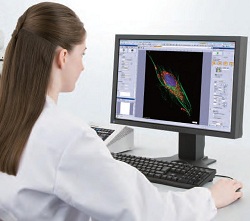THE LATEST iteration of CellSens microscopy software from Olympus includes new imaging modules that promise many benefits, especially to inexperienced users.

CellSens 1.7 is the latest iteration of Olympus's microscopy software
CellSens 1.7 includes Well Navigator to streamline the imaging of multi-well experiments, along with High Dynamic Range (HDR) imaging to improve the exposure of challenging samples.
Other new features include 2D deconvolution for maximising image clarity, and a new database model for the easier management of large data repositories.
The software supports a wider range of cameras and is compatible with the Olympus Real Time Controller (RTC), which the company says is especially useful with high-end imaging techniques such as total internal reflection fluorescence (Tirf).
Olympus says CellSens 1.7 is the key element that blends together its frames, cameras, and optics to form a powerful and easy to use microscopy system.
Working with challenging samples that simultaneously contain very light and dark staining, the HDR mode can bring out all the details in the sample with just one click.
The 2D deconvolution tool also improves images by quickly applying a true de-convolution on a single image, without the need for acquiring a Z-stack, for crystal clear images of samples stained with multiple fluorochromes.
The optional Well Navigator offers customisable pre-sets for a wide range of plate formats and panoramic imaging of each well. As focusing is an issue when moving across large multi-well plates, this module works with the Olympus ZDC focus compensation unit which automatically maintains perfect focus.
